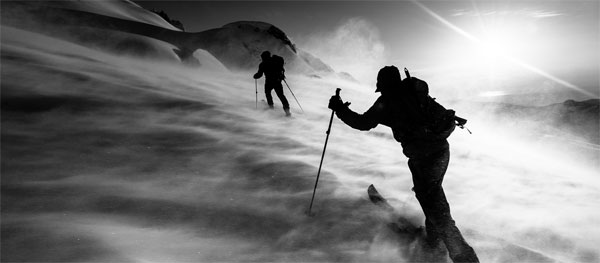The Human Factor, Chapter 1: Call of the Sirens
Black Diamond Presents: The Human Factor, a five-part multi-media story that investigates the decisions skiers make in avalanche terrain. Starting November 11th, every Tuesday for five weeks, a new chapter will be released.
-Written by David Page
DAWN ROSE SLOWLY on the morning of February 11, 2014. It was a Tuesday, though none of the eight skiers staying at the Schneider Cabin in Oregon's Wallowa Mountains thought much about what day of the week it was. They were two days into a five-day backcountry hut trip, which meant two more full days of ski touring before they'd have to pack up and make the long haul back to the real world. The day before, they'd hiked and skied 3,000 vertical feet of excellent north-facing powder. And that morning there was another six inches of fresh outside the cabin, with more coming down.
It had been a weird and variable winter across the West. Ten people had already died in avalanches nationwide, four in just the last three days. In the Wallowas, a rugged playground of vertical granite and basalt with at least 31 peaks that rise above 9,000 feet, tucked away in northeastern Oregon, it'd been warm and then cold and then warm again, with early season snowfall significantly below average. Finally, at the end of January, the jet stream shifted south, bringing a steady winter cycle: 18 inches, then six, then another 18 to 23 as it grew progressively colder and drier. In the end, nearly four feet of new snow fell over 10 days at the Schneider Meadows SNOTEL plot, located at 5,400 feet, 1,800 feet below the old miner's cabin.
Then it warmed up again. Two days prior, on the morning of the 9th, as the group set out on a six-mile snowmobile tow-in to start the trip, it was raining in the town of Halfway. Higher up, the gods dropped four inches of heavy sludge on top of a frozen crust. The usual skin track, covering the last two and a half miles from the drop-off point to the cabin, was blown out by a natural slide. So they'd blazed an alternate, safer route to the cabin, then spent the first afternoon practicing avalanche rescue protocol and taking a short, low-risk tour near the cabin.
The thing about the Schneider Cabin, tucked as it is in a stand of old-growth whitebark pines on a high shelf below the steep southeast face of 8,643-foot Cornucopia Peak, is that there's really no moderate terrain. From the cabin upward it's all fairly burly and exposed. Which is great in the right conditions. But when things are sketchy, options are limited.
Read more of, Chapter 1: Call of the Sirens, on powder.com
